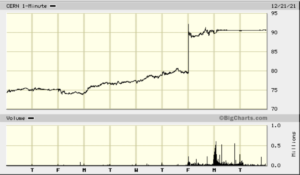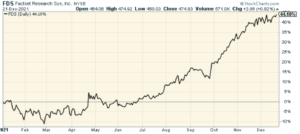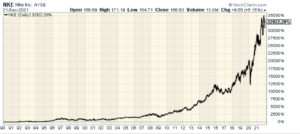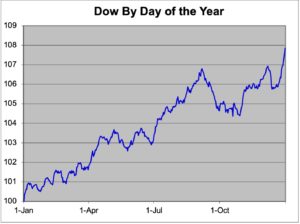CWS Market Review – December 21, 2021
(This is the free version of CWS Market Review. I’m going to unveil our 2022 Buy List this Friday, December 24 in our premium issue. To see the new list, make sure you’re a premium subscriber. You can get the premium newsletter for $20 per month or $200 for the whole year.)
Oracle to Buy Cerner for $95 per Share
Great news for our Buy List. This week, Oracle (ORCL) said it’s going to buy Cerner (CERN) for $95 per share. This is a huge win for us.
Earlier, we knew that the companies had been discussing a potential deal, but that became official yesterday. This will be Oracle’s largest deal ever. The deal is all-cash and it includes Cerner’s debt.
The story initially broke in the WSJ on Thursday evening. Shares of Cerner had closed at $79.49 that day. The stock soared on Friday and eventually closed at $89.77. That was a gain of nearly 13%.
It’s even more impressive when you consider that Cerner had been rallying going into the announcement. As recently as December 1, shares of Cerner closed at $70.01 per share. If you include that, then the stock has gained close to 30% in a few weeks.
If you look closely, you can almost make out when the news broke:

The deal comes to $28.3 billion. While Oracle will pay $95 per share for Cerner, the stock will probably drift around in the low $90s until the deal closes. Once the lawyers get involved, it takes time to get the deal done.
There are also regulatory hurdles to deal with. There’s also the possibility that the deal will fall through. It’s unlikely, but it does happen. Sometimes shareholders revolt and enough of them can get their way. Until then, shares of Cerner will trade like a low-quality bond that will mature at some point at $95 per share.
From Bloomberg:
Oracle Chief Executive Officer Safra Catz said the acquisition should be “immediately accretive to Oracle’s earnings” on an adjusted basis in the first full fiscal year after closing and contribute “substantially more to earnings in the second fiscal year and thereafter.” The transaction is expected to close next year, the companies said.
Oracle, the second-biggest software maker by revenue, is best known for legacy database products. The company has struggled in recent years to gain ground in cloud computing, in which companies rent data storage and analytic power from large server centers, trailing far behind market leaders such as Amazon.com Inc. and Microsoft Corp.
The deal for Cerner gives Oracle a huge foothold in technology for the health care industry — a sector expected to spend $15.8 billion on cloud infrastructure and software by 2023, according to market researcher IDC — given Cerner’s robust user base, which includes many of the top U.S. hospital systems. And as Oracle moves more of Cerner’s systems onto its own cloud infrastructure, the company gains an important case study to help future sales.
This deal caught some people off guard because Cerner’s new CEO started only a few weeks ago. As much as I like Cerner, the stock had not been a terribly strong performer for us this year.
We added CERN to our Buy List in 2016. Since then, the company has performed well but the stock has been somewhat mediocre. Oracle had also been on our Buy List from 2011 to 2015.
FactSet Delivers Big Earnings Beat
This morning, we got an earnings report from FactSet (FDS). This is for its fiscal Q1 which ended in November. FactSet has been one of our best-performing stocks this year with a gain of 44% (including dividends).
The company reported fiscal Q1 earnings of $3.25 per share. That was up 12.8% over last year and it beat Wall Street’s forecast of $2.99 per share.
Quarterly revenues rose 9.4% to $424.7 million. Organic sales rose 9.1% to $423.2 million.
The key stat for FactSet is Annual Subscription Value (ASV) plus professional services. At the end of the quarter, that stood at $1.7 billion which is up from $1.6 billion a year ago.
Most importantly, the company reaffirmed its expectations for Fiscal 2022:
• Organic ASV plus professional services is expected to increase in the range of $105 million to $135 million over fiscal 2021.
• GAAP revenues is expected to be in the range of $1,705 million to $1,720 million.
• GAAP operating margin is expected to be in the range of 31% to 32%.
• Adjusted operating margin is expected to be in the range of 32.5% to 33.5%.
• FactSet’s annual effective tax rate is expected to be in the range of 14.5% to 15.5%.
• GAAP diluted EPS is expected to be in the range of $11.60 to $11.90. Adjusted diluted EPS is expected to be in the range of $12.00 to $12.30.
FactSet is also one of the newest members of the S&P 500. The stock gapped down this morning. At one point, shares of FDS were down 4.4%. Cooler heads prevailed and FDS later rallied. The shares were up today by 0.8%.

Nike Had to Cancel 130 Million Orders
Yesterday, Nike (NKE) reported very good earnings. The sneaker company made 83 cents per share which was 20 cents more than expectations. The stock rallied 6.15% today.
Despite the earnings beat, Nike has been experiencing weakness in China. Sales in North America have more than made up the difference.
The reason why I wanted to bring Nike to your attention is this amazing stat. Last quarter, Nike had to cancel 130 million units due to factory closures. The company said that those problems are being worked out.
Since the beginning of 1990, Nike has gained nearly 33,000%:

The Santa Claus Rally
Normally, I don’t place a great deal of faith in calendar effects and the stock market. After all, the stock market has been around for a long time. If you slice and dice the data long enough, you’re bound to find an oddball stat.
Still, I am impressed by the Santa Claus Rally. This is the phenomenon of the market performing well at Christmastime. The numbers are truly remarkable.
I’ve taken the entire history of the Dow Jones, which dates back from more than 125 years ago, and I’ve found that one-third of the stock market’s entire gain has come between December 22 and January 8.
Here are the numbers. The Dow has an average annualized gain (excluding dividends) of 7.85% per year. From December 22 to January 8, the Dow has an average gain of 2.82%. While that may not sound like a lot, it’s very large considering the short time span—it’s only about 5% of the year—and that’s an average of 125 years’ worth of data. For the rest of the year, the other 95%, the Dow has gained just 4.89% per year.
Here’s how the Dow has performed on average during the year:

Thank you, and I want to wish everyone a Merry Christmas and a happy and healthy holiday season. I’ll have more for you in the next issue of CWS Market Review.
– Eddy
P.S. Don’t forget to sign up for our premium newsletter.
Posted by Eddy Elfenbein on December 21st, 2021 at 7:44 pm
The information in this blog post represents my own opinions and does not contain a recommendation for any particular security or investment. I or my affiliates may hold positions or other interests in securities mentioned in the Blog, please see my Disclaimer page for my full disclaimer.
- Tweets by @EddyElfenbein
-
-
Archives
- May 2024
- April 2024
- March 2024
- February 2024
- January 2024
- December 2023
- November 2023
- October 2023
- September 2023
- August 2023
- July 2023
- June 2023
- May 2023
- April 2023
- March 2023
- February 2023
- January 2023
- December 2022
- November 2022
- October 2022
- September 2022
- August 2022
- July 2022
- June 2022
- May 2022
- April 2022
- March 2022
- February 2022
- January 2022
- December 2021
- November 2021
- October 2021
- September 2021
- August 2021
- July 2021
- June 2021
- May 2021
- April 2021
- March 2021
- February 2021
- January 2021
- December 2020
- November 2020
- October 2020
- September 2020
- August 2020
- July 2020
- June 2020
- May 2020
- April 2020
- March 2020
- February 2020
- January 2020
- December 2019
- November 2019
- October 2019
- September 2019
- August 2019
- July 2019
- June 2019
- May 2019
- April 2019
- March 2019
- February 2019
- January 2019
- December 2018
- November 2018
- October 2018
- September 2018
- August 2018
- July 2018
- June 2018
- May 2018
- April 2018
- March 2018
- February 2018
- January 2018
- December 2017
- November 2017
- October 2017
- September 2017
- August 2017
- July 2017
- June 2017
- May 2017
- April 2017
- March 2017
- February 2017
- January 2017
- December 2016
- November 2016
- October 2016
- September 2016
- August 2016
- July 2016
- June 2016
- May 2016
- April 2016
- March 2016
- February 2016
- January 2016
- December 2015
- November 2015
- October 2015
- September 2015
- August 2015
- July 2015
- June 2015
- May 2015
- April 2015
- March 2015
- February 2015
- January 2015
- December 2014
- November 2014
- October 2014
- September 2014
- August 2014
- July 2014
- June 2014
- May 2014
- April 2014
- March 2014
- February 2014
- January 2014
- December 2013
- November 2013
- October 2013
- September 2013
- August 2013
- July 2013
- June 2013
- May 2013
- April 2013
- March 2013
- February 2013
- January 2013
- December 2012
- November 2012
- October 2012
- September 2012
- August 2012
- July 2012
- June 2012
- May 2012
- April 2012
- March 2012
- February 2012
- January 2012
- December 2011
- November 2011
- October 2011
- September 2011
- August 2011
- July 2011
- June 2011
- May 2011
- April 2011
- March 2011
- February 2011
- January 2011
- December 2010
- November 2010
- October 2010
- September 2010
- August 2010
- July 2010
- June 2010
- May 2010
- April 2010
- March 2010
- February 2010
- January 2010
- December 2009
- November 2009
- October 2009
- September 2009
- August 2009
- July 2009
- June 2009
- May 2009
- April 2009
- March 2009
- February 2009
- January 2009
- December 2008
- November 2008
- October 2008
- September 2008
- August 2008
- July 2008
- June 2008
- May 2008
- April 2008
- March 2008
- February 2008
- January 2008
- December 2007
- November 2007
- October 2007
- September 2007
- August 2007
- July 2007
- June 2007
- May 2007
- April 2007
- March 2007
- February 2007
- January 2007
- December 2006
- November 2006
- October 2006
- September 2006
- August 2006
- July 2006
- June 2006
- May 2006
- April 2006
- March 2006
- February 2006
- January 2006
- December 2005
- November 2005
- October 2005
- September 2005
- August 2005
- July 2005
 Eddy Elfenbein is a Washington, DC-based speaker, portfolio manager and editor of the blog Crossing Wall Street. His
Eddy Elfenbein is a Washington, DC-based speaker, portfolio manager and editor of the blog Crossing Wall Street. His